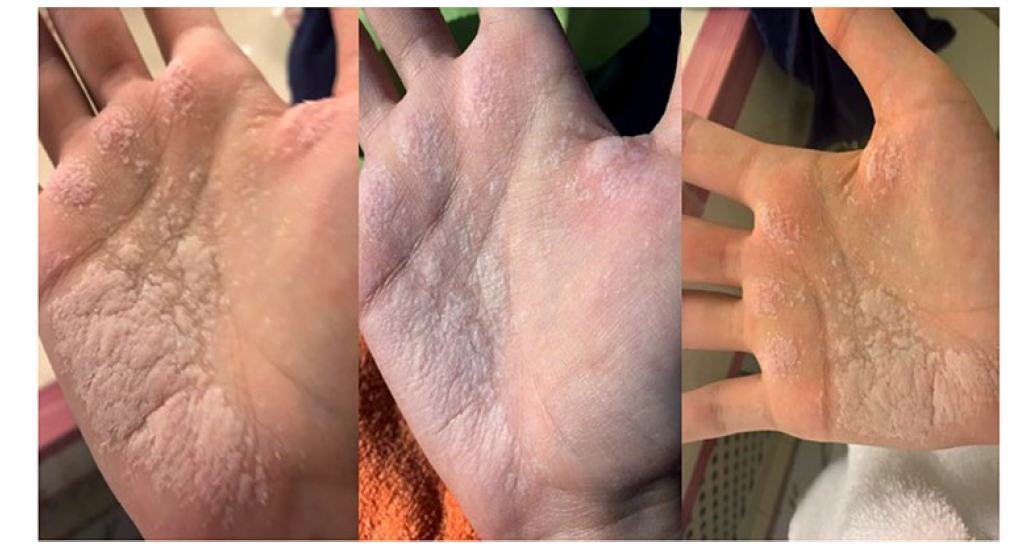Introduction
Aquagenic wrinkling of the palms (AWP) is a dermatolo-gical condition characterized by skin wrinkling of the palms with oedema and confluent whitish papules following brief contact with water.1,2It was first described in 1974 by the paediatrician R. B. Elliot in children with cystic fibrosis (CF), the most frequent severe autosomal inherited abnormality, caused by mutations in the cystic fibrosis transmembrane conductance regulator (CFTR) gene.3 Since then, the association has been confirmed by several smaller studies and case reports and also in individuals where a single mutation of the CFTR gene has been reported, as well as in patients with non-classic CF.
Case Report
A 21-year-old Caucasian woman presented with a 12 months history of pruritic wrinkling of the palmar skin after brief contact with water. Symptoms were temporary and spontaneously regressed within a few minutes (15 minutes) after hands drying. On clinical examination, she developed substantial oedema and a whitish papillomatous appearance of the palms after immersion of the hands in water for about 5 to 7 minutes (Fig. 1). She had no history of hyperhidrosis or other skin condition, as well as no other concomitant diseases, except for chronic rhinosinusitis. She was not on any medication and had no family history of CF or upper airway pathology. A clinical diagnosis of AWP was made and a full medical routine was ordered, namely chest X-ray, chest computed tomography (CT) scan, sinus X-ray, sweat test and spirometry with no abnormality found. A complete CFTR gene sequencing was performed, leading to the identification of a heterozygous mutation for p.Phe508del. No specific treatment was applied; the patient and her family were referred to a genetic counselling consultation where global genetic counselling was made without family testing.
Discussion
CF is an autosomal recessive disease in the CFTR gene leading to abnormal transport of chloride over epithelial membranes that results in reduced electrolyte reabsorption and raised concentrations of chloride in sweat and organ damage in the respiratory, pancreatic, biliary, reproductive and gastrointestinal systems.2,4 Currently, nearly 2 000 mutations have been identified and in recent years, with help from the field of genetics, the diagnosis of CF has been extended to include milder phenotypes regarded as non-classic CF or CFTR related disorders.2,5Some of these patients have mild or no lung disease with unusual clinical features such as chronic sinusitis or male infertility, and AWP could be another feature that may fall in this category.4
The link between CF and AWP was first established in 1974 but the exact physiological mechanism remains unknown. In the past decades, studies documented a prevalence of AWP between 78% and 84% in patients with CF and of 25% in CF carriers.3,5,6Nonetheless, in recent years, reports of AWP related to a carrier state of CF like the one in this article have exponentially increase.5
In conclusion, AWP is yet an unknown condition with a strong established connection with classic CF, non-classic CF and CF carriers. The identification of this phenomenon with a directed clinical history, physical examination and appropriate complementary study is mandatory and can be of great impact in individuals of childbearing age, knowing that the search for a mutation in the CFTR gene must be extended to the full gene sequencing and not only to the most common mutations associated with this disease.
















